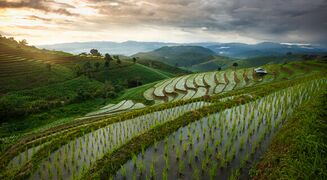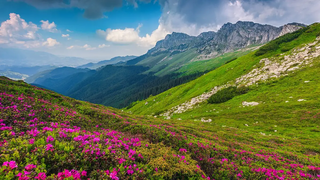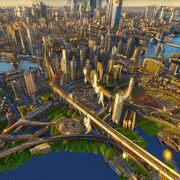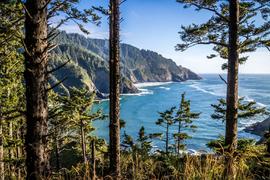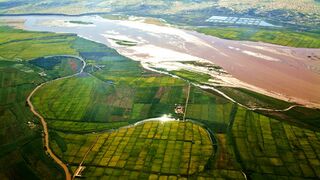Canespa: Difference between revisions
PotatoLover (talk | contribs) mNo edit summary |
PotatoLover (talk | contribs) mNo edit summary |
||
| Line 237: | Line 237: | ||
[[Hamuq City|Hamuq city]] will also double as the largest research site in [[Canespa]]. Focused on researching the limits of plant genetic modification. The city will test everything from the modification of taste, to size, to growth speed. Genetically modified plants are already in use in the city helping to increase growth speed. | [[Hamuq City|Hamuq city]] will also double as the largest research site in [[Canespa]]. Focused on researching the limits of plant genetic modification. The city will test everything from the modification of taste, to size, to growth speed. Genetically modified plants are already in use in the city helping to increase growth speed. | ||
The city around [[Hamuq]] is also in construction as the [[Canasta Company]] heads all major construction sites in the area. There is currently a wait list in [[Canespa]] slowly building up. Any employee of the [[Canasta Company]] can sign up to be moved to [[Hamuq]] once the city has been completed. Currently there is at least one director of the board on sight at all times monitoring the construction. Production of small amounts of the food in some of the towers has started as construction nears its end.[[File: | The city around [[Hamuq]] is also in construction as the [[Canasta Company]] heads all major construction sites in the area. There is currently a wait list in [[Canespa]] slowly building up. Any employee of the [[Canasta Company]] can sign up to be moved to [[Hamuq]] once the city has been completed. Currently there is at least one director of the board on sight at all times monitoring the construction. Production of small amounts of the food in some of the towers has started as construction nears its end. | ||
[[File:HamuqCity2.jpg|thumb|An expansive view of Hamuq Cities towers]] | |||
===Industries and Sectors=== | ===Industries and Sectors=== | ||
| Line 246: | Line 247: | ||
Along with potatoes [[Canespa]] produces , grapes, strawberries, blueberries, cherries, apples, cherries, peaches, pears, plums, prunes, nectarines, apricots, hazelnuts, walnuts, chestnuts, pecans, asparagus, zucchini, mushrooms, peppers, tomatoes, cucumbers, wheat, canola, oats and barley. Along with all of these is the second largest food export of [[Canespa]], seafood. [[Canespa|Canespian]] fisherman sail all along the coast catching various seafood including but not limited to salmon, halibut, rockfish, hake, sablefish, herring and tuna. Shellfish include clams, oysters, crab, prawns, geoduck, sea urchins, and sea cucumber. The seafood is often transported to [[Port Extranjero]] directly with the sea but the canals can be used additionally. | Along with potatoes [[Canespa]] produces , grapes, strawberries, blueberries, cherries, apples, cherries, peaches, pears, plums, prunes, nectarines, apricots, hazelnuts, walnuts, chestnuts, pecans, asparagus, zucchini, mushrooms, peppers, tomatoes, cucumbers, wheat, canola, oats and barley. Along with all of these is the second largest food export of [[Canespa]], seafood. [[Canespa|Canespian]] fisherman sail all along the coast catching various seafood including but not limited to salmon, halibut, rockfish, hake, sablefish, herring and tuna. Shellfish include clams, oysters, crab, prawns, geoduck, sea urchins, and sea cucumber. The seafood is often transported to [[Port Extranjero]] directly with the sea but the canals can be used additionally. | ||
The largest non-agricultural industry in [[Canespa]] is lumber, this is thanks to the massive pine forests in the northern stretches of [[Canespa]]. Though lumber is not the focus of [[Canespa|Canespian]] industry it is still a massive component of it providing Canespian’s with cheap wood. The types of wood cut down in [[Canespa|Canespian]] forests includes but is not limited to coniferous or softwood, Douglas fir, western hemlock, Pacific silver fir, western red cedar, lodgepole pine and interior spruce. For every tree cut down in Canespa (including trees cleared for buildings) needs to be replaced with at least three saplings. This ensures a continuously growing economy. Additionally the [[Canasta Company]] has a constant fire watch patrol that ensures there are no forest fires or forest fire causing variables in and around company tree farms. | The largest non-agricultural industry in [[Canespa]] is lumber, this is thanks to the massive pine forests in the northern stretches of [[Canespa]]. Though lumber is not the focus of [[Canespa|Canespian]] industry it is still a massive component of it providing Canespian’s with cheap wood. The types of wood cut down in [[Canespa|Canespian]] forests includes but is not limited to coniferous or softwood, Douglas fir, western hemlock, Pacific silver fir, western red cedar, lodgepole pine and interior spruce. For every tree cut down in [[Canespa]] (including trees cleared for buildings) needs to be replaced with at least three saplings. This ensures a continuously growing economy. Additionally the [[Canasta Company]] has a constant fire watch patrol that ensures there are no forest fires or forest fire causing variables in and around company tree farms. | ||
The [[Canespa|Canespian]] industry is constantly evolving and new technologies are being created to assist in growth. [[Canespa|Canespa’s]] largest tech department is specifically used to genetically modify plants to further their output. New machines are being developed to harvest wood and food faster and entire infrastructure projects are devoted to the production of food. [[Hamuq city]] is a prime example of all of these factors and will be a completely automated city that can produce more food than any other location on the planet. The [[Canespa|Canespian]] industry is growing fast along with its population which is expected to surpass 100M by 2042. | The [[Canespa|Canespian]] industry is constantly evolving and new technologies are being created to assist in growth. [[Canespa|Canespa’s]] largest tech department is specifically used to genetically modify plants to further their output. New machines are being developed to harvest wood and food faster and entire infrastructure projects are devoted to the production of food. [[Hamuq City Reservoir Crisis|Hamuq city]] is a prime example of all of these factors and will be a completely automated city that can produce more food than any other location on the planet. The [[Canespa|Canespian]] industry is growing fast along with its population which is expected to surpass 100M by 2042. | ||
Canespa's economy also extends into foreign lands through the Canasta Company, although areas outside the country don't technically consist of Canespa's economy, they do feed into it. The Canasta Company is international and has made deals in many areas including Varshan and the Iles Evangeline. | [[Canespa|Canespa's]] economy also extends into foreign lands through the Canasta Company, although areas outside the country don't technically consist of [[Canespa|Canespa's]] economy, they do feed into it. The [[Canasta Company]] is international and has made deals in many areas including Varshan and the Iles Evangeline. | ||
===Currency=== | ===Currency=== | ||
Revision as of 19:57, 5 March 2024
Congressional Company of Canespa Canespa | |
|---|---|
Motto: Pisi runakunaq hallp'anqa allin kawsay hallp'an The land of few is the land of prosperity | |
Anthem: Your song | |
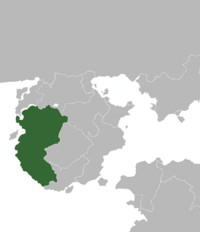 Location of Canespa (green) in Cusinaut (gray). | |
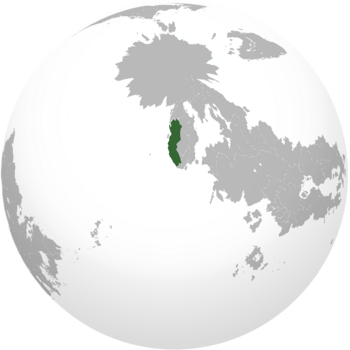 | |
| Capital and largest city | Canestapa |
| Official languages | Papasimi |
| Ethnic groups | Southern Canespian Northern Canespian |
| Religion | M'acunism |
| Demonym(s) | Canespian |
| Government | Banana Republic |
• Wasiexu | Túpac Amaru |
• Your head of government if applicable, otherwise a legislative leader | Jane Blow |
• A legislative leader of a different house, if applicable | Georgw Blow |
| Legislature | House of Union |
| House of Union | |
| None | |
| Establishment | |
• The Wasi's proposal | 1458 |
| Area | |
• Total | 1,357,956.67 km2 (524,310.00 sq mi) |
| Population | |
• Estimate | 91,300,000 |
• Census | 87,243,504 |
| GDP (nominal) | estimate |
• Total | 2,575,961,100,000 |
• Per capita | 29,507 |
| Gini | 32.5 medium |
| HDI (2031) | 0.649 medium |
| Currency | Capesa (CPA) |
| Driving side | right |
| Calling code | +952 |
| Internet TLD | .cp |
| Today part of | Canespa |
Canespa, officially the Congressional Company of Canespa, is a country in Cusinaut. It is neighbored by , Netansett, Porfiria, the Algosh Republic, Ashkenang, Maloka, Caldera, and Burgoignesc Port Extranjero. Canespa is a Semi-Monarchical Congressional Company, meaning that it is controlled by a company known as the Canasta Company. Thanks to a company controlled government, one of Canespa’s biggest drives is profit. Canespa values its farmland and it will do anything to protect it, Canespas largest farms are in Chawpi Valle, the Wallowaki mayu as well as the southern plains. These areas are where most Canespians live and work.
Canespa as an idea has existed for thousands of years but the actual state didn’t unify until 1458 under the Wasi King. The monarchy of Canespa existed up until the 80s when the Canasta Company seized control of the government via a slow transition as the company began to mold with the government. There was no one massive coup but instead a slow and painful death for the government as it became more and more reliant on the company. Since Canespa effectively became a company its economy has boomed and so has its population. The company modernized Canespa leading to a population boom that is still ongoing. Canespa has one of the fastest growing populations in the world thanks to the fact that while modern it remains a fairly cheap place to live and it also remains an agrarian society.
Thanks to the company Canespa is filthy rich for its size and it has invested in a number of large infrastructure projects in order to further modernize and expand upon the country. The biggest of these projects is Hamuq city which is a fully automated farming city that will be the single largest complex of food production on the planet. Once you add up the Canasta Companies food production it comes up to a total of 750 million metric tons of food per year. Or 8.6 metric tons of food per capita. Canespa could feed its population 10 times over in a comfortable manner. All of this food is then sold to Burgundie, after this Burgundie exports the food all around the world.
Etymology
Canes comes from the word "Canasta" which means Basket in the Papasimi Dialect. The first use of this name is unknown but it likely dates back thousands of years to some small tribe in the region. While pa comes from the word Potato. The meaning of these two words is vary significant to Canespa as they represent the country. While no one knows the original use of basket in the countries name it most likely came from a small tribe somewhere in Canespa that eventually found its way into Canespa's name sake. While the baskets origin is must more wondered upon, the Potato in Canespa's name came directly from House Papa and exstensive worship of the starchy food. It also is vary important to Canespian culture as a whole.
History
First era
The first signs of human inhabitants within the region originate in around 19,000 B.C.E as early forms of scavenging tool and clothing have been found.
Second era
During the 8th through 14th century the country slowly began to centralize more into a state. The different families and clans slowly began to decrease in number but after the fall of House "Metal" in 1395, the clans stagnated as any move against one another would break the balance of power that existed. This all changed thanks to the Wasi King in 1458. He was a member of House "Light". The Wasi King proposed that all the houses form together and create the country of Canespa. A country that could withstand the forces of any neighboring land. The houses were convinced by both by the Wasi King's legendary speaking skills and the looming threat of colonizers in the area. For the next 300 years Canespa would almost totally remove itself from the world.
The Wasi King
The Wasi King has been a major individual and title that has greatly effected Canespa up to the modern day. The Wasi King first appeared in the year 1157. He was able to unite four of the houses at the time with a great war headed by the House Wasi. Who conquered House Kuskachay, House Espada, and House Kanchi. Though this union was short lived it cemented the concept of the Wasi King. Any person or persons that united multiple houses would be known as the Wasi King. There name(s) would also converted to Wasi and they would be regarded as one individual. The Wasi King was the supreme ruler up until the Canasta Company gained full control of the government in the 60s. Though some argue that the board of executives is the Wasi King. The board has interestingly never claimed this title and has effectively ended the tradition somewhat.
Third era
The reign of the Wasi King lasted for ages, and it brought relative prosperity to area. The country slowly expanded in a small series of conflicts that shaped the modern borders of Canespa. This was a quiet time in Canespian history with not much going on. the threat of colonizers was on the rise but none had expressed much interest in Canespian land. There was a brief civil war between Canespa's south and its north over if the houses should even remain united with the threat of colonizers being a seemingly far one. This civil war ended in a northern victory which led to the maintaining of the union of houses. This could well have been a turning point in Canespian history.
Fourth era
During the Age of Sail Canespa and the Maritime Deric Duchy of Martilles formed an alliance that guaranteed that no Occidental power would try to colonize Canespa. This economic and military alliance would go on to greatly influence Canespian history and it would influence the rise of the Canasta Company. Though the original alliance was vary primative compared to its current state. It is still was ended up saving Canespa as it held off any threat of colonization while also giving Canespa time to modernize on its own in a natural process that took centuries but would eventually pay off. Additionally Canespa would eventually start to modernize economically as industries and large companies began to form. This is the birth of the Canasta Company. An organization that would come to define Canespa and finally end the Wasi Kings reign.
Fifth/Sixth era
The Canasta Company is one of the products of the 19th century. It revolutionized almost everything about the country. From healthcare to labor to education everything changed when the company started leading the country. The original executives who first led the country all had lived and learned in foreign lands and were ready to bring that knowledge and prosperity to Canespa. They first brought in mass produced modern farming equipment while also reforming the education system while updating almost every curriculum within Canespian schools. The following technological boom lead into the Canespian population boom which has doubled the number of Canespian's since 1980. The company gave Canespa all the tools it needed to thrive. Though some conservative leaning members of Canespian society fought back for some time they were quickly shot down as the prosperity within Canespa soared. Due to this new technology Canespa could produce food on a once thought to be impossible scale for a nation its size.
Geography
-
Terrace farms along Canespa's hills.
-
Flower blooms along the edges of Canespa's mountains.
-
Downtown Canestapa.
-
The southern coast of Canespa.
-
Large farms surrounding Canespa's largest river.
What is the general explanation of how your country exists within the world?
Climate and environment
Canespa, while being the in the far north of the planet, maintains a mild climate thanks to the currents of the ocean to its west. This has helped it maintain a climate suitable for farms. Canespa's soil is thin and grainy which means it is perfect for the growth of potatoes. This soil has effectively shaped Canespa's history into one of a rich monoculture that can produce more food then its people would ever need and more. The booming forests in the northern reaches of Canespa have allowed for a large logging industry to start in a few of Canespa's provinces.
Government and Politics
Canespa is effectively ruled by the Canasta Company. But its still split into two "branches" including the Board of Executives and the House of Union.
Executive
The countries Executive branch is lead by the Board of Executives a 12 person council. There is a mandated two members from each of the houses. Additionally one member is mandated to be a foreigner from a foreign branch of the company. Since this position was mandated it has been controlled by Burgoignesc individual. The last member is the head of the council. They are required to be from House Wasi. This individual most be either a child or grandchild of the previous council head above the age of 25. The council heads official position name is the Wasiexu (Was-ee-x-oo). The Wasiexu is the effective CEO of the Canasta Company. The Board of Executives is in charge of all of Canespa's foreign relations and most of its economic decisions.
To Become A member of the Board of Executives a person must be of atleast the age of 25 (though this is rare) and have proved themself within the Canasta Company working there way up the chain of command. Each executive is required to have a designated heir that holds a high ranking position in the company while also being of the same house. As for the Wasiexu. They are voted on by the House Union. Usually there are only 3-4 runners for the position considering the strict requirements. Additionally the foreign spot is chosen by the other executives and not by the previous foreigner.
Federal Subdivisions
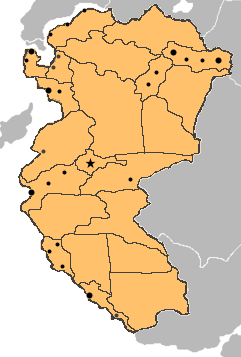
Canespa has a vary unique way of sub dividing the country. There are two types of divisions, there are states or suyukuna's, and there are mikuna's. Suyukuna's have larger population centers and have a more traditional government structure. They tend to have a slightly more democratic means of government that is still heavily influenced by the Canasta Company. Suyukuna's have a more right leaning economic structure where money is used to pay workers over resources in many cases.There are ten of these subdivisions in Canespa with some being more populous then others. This includes the capital district Papua. On the other hand the mikuna's are much more rural and there laws are vary different. The already strict rules on how you interact with the environment are increased to a new level. The economy is more left leaning with resources and housing being used as payment more so then money. Most of the population tends to live in Ilaqta's. There are 12 mikuna's making them the most common subdivision in Canespa. Most mikuna's are landlocked with only three of them having any coastline. Each subdivision is usually controlled by the Canespian House that has the largest stake in the population of the division. The election of this house is monitored by the Canasta Company and the Wasiexu. Based on which house controls a certain division can determime anything from the laws to the culture to the worldview of the people in the division. This gives each division a different and distinct culture. This also allows for the addition of new divisions if the need arrives.
Politics
The only place where any pseudo parties exist is the House of Union. Since worker unions are illegal in the country, an alternative was created in the form of the House of Union. Its job is to make sure the houses left over from the Wasi-King are reigned in and happy. Each house controls a certain amount of members in a 275 person senate. This senate will vote over cultural and internal issues. Effectively acting as a guard to stop extremest Executives from gaining to much power. This senate has little power though and is not always effective. The houses include House Papa, House Espada, House Kuskachay, House Qispisqa Kay, and House Kanchi. Historically House Kanchi has reigned supreme but since 1994 House Papa has held a commanding lead. Bribery is common within the House of Union. Different Executives will occasionally bribe entire houses in order to gain more power within the country.
The house will vote on bills passed to them by the countries executives. There are different types of bills that require different percentages of the house. The main three are economic, law, and defense. A bill can be passed to the House of Union once any number of executives have signed the bill. The percentage needed to pass any bill starts at 92.5% with one executives signature and goes down by 7.5 percent with every additional signature. Defense bills add 10%, Law bills don't effect the percentage and Economic bills subtract 10%. The percentage needed to win maxes out at 92.5% while the minimum percentage needed for any bill is 10%.
The House's members are chosen through a series of recommendations made by different high officials in different industries and recommendations from different training programs. These recommended men and women are then voted in by anyone with a managing position within the company.
Law
Due to native roots Canespa’s judicial system is completely different to most non-Cronan countries. The goal of the judicial system is not to prosecute the wrongdoer, but to instead solve what went wrong between the defendant and prosecutor. By doing this the judicial process has two missions, stop the conflict from continuing, and finding out what the best course of action is. In one particular case a man attempted to murder the victim because of the long standing rivalry between his and the victims family. As the case evolved the Council of Elders got together to consider the best possible course of action, after talking to both the victim and the criminal in private, then together as a group. Following an intense and complex discussion two possible options were discussed, either sending one family away and changing their names while enrolling the criminal in a therapy group, or for the victim and the criminal to engage in a weekly discussion where the two families settle their differences and keep friendly contact. Once both parties agreed the second option was decided upon. Today the families have become strong allies and are now neighbors. The former criminal has not engaged in any illegal activity since the court case and has said that he strongly regrets his former actions.
Canespa's laws are rooted in M'acunism and its large production of crops. It is illegal to bring any uninspected food into the country due to the fear of any and all crop diseases that can effect the nation's output. Almost all actions that significantly increase the Co2 output of Canespa are also illegal without proper permission from the government. It is also illegal to raze the ground of an area without the proper permits from the government ensuring it wont highly affect the native wildlife. Due to the nature of the countries government there is no minimum wage and all wage related laws are directly run by the Canasta Company. In a similar manner taxes barely exist in the country and much of the money the government makes is sent to them via the Canasta Company. Though if you live in the country and work for any corporation besides the Canasta Company then taxes can raise drastically though this is rare.
Socially the country has no laws regarding ethnic background and there is little to no discrimination in the country. It's truly a meritocracy at heart and what you earn/receive from the company is determined by your output.
Demographic
Ethnicity
Self-reported ethnic origin in Canespa (2033)
The main ethnic group in the country is Canespian which consists mainly of anyone from the 7 Houses. Though Canespa is a big place so most of the time its split into two, Southern Canespian and Northern Canespian. Northern Canespian is the bigger of the two ethnicities being roughly 68 million strong. While there are only roughly 30 million southern Canespians the culture is even more rural then its northern counterpart. Northern and southern Canespian's have relatively good relations and have rarely fought in the past. The Northern Canespian's were the only ones who were part of the original Wasi Kings kingdom which quickly fell apart.
Additional ethnic groups include cultures adjacent to Canespa, as well as a large Bergendii minority and a fairly notable minority of Fanerian's. The Bergendii minority is a fairly recent development that has come from small amounts of immigration caused by Port Extranjero. The Fanerian minority is much more ancient as it comes from the short lasting coastal settlements created by Faneria along the Canespian shoreline. These settlements were raided and the surviving citizens of these settlements were slowly integrated into Canespian society.
Language
Papasimi is the official language of Canespa. The language is thousands of years old and has not spread far out of Canespa. It was used for a small amount of time in the more western areas of the Northern Federation but it died out there after the collapse of the federation. The languages origin point is often debated by scholars. While some say it most likely came from the mountains do to many of the mountains in the region having there names deeply rooted in the language while others believe that it started along the coast which would have allowed it to spread faster. Even some believe that it didn't originate in the Cusinaut at all and came from the mainland thousands of years ago in small tribes.
The adoption of the alphabet in Papasimi is a fairly recent development. Before this the only writing done of the language was in complex ruins and images that were hard to read and hard to write. Ultimately the language was changed and each word was crafted into a new spelling through a complex process that lasted years.
Religion
Religious affiliations in Canespa (2033)
Education
Education up to ones 12th birthday is mandatory and training programs are free if you agree to go into that profession after the program is over. This means that in a general sense most Canespians are educated. Only a few training programs are deemed as higher education by other countries though. So only around 4% of Canespians engage in high education. Literacy rates in the country are 98.9%
Culture and Society
Education
In Canespa, general education for most only lasts till ones 12th birthday. At which point they will start a training program for whichever profession they will ultimately spend most of their life doing.(75% will be in some type of farming) Most training programs last from 2-4 years at which point one will start working. To become a teacher of general education one most pass specific tests and strict backround checks, becoming a teacher or trainer is not easy in Canespa.
In order to qualify for a certain training program you need to either have shown certain skills by doing skill camps in your younger years or maintain certain grades for more executive type training programs. Skill camps are week long camps that you can decide to participate in during your general education. For 3 separate weeks during the school year school is canceled and skill camps open up in there place. There are fall, winter and spring skill camps. Some skill camps only have one location in the country while some have many. Some notable skill camps include the football camp, the harvesting camp, the planting camp, the leadership camp, the peace and order camp, the military camp, the technology and discovery camp, the religious studies camp, and last but not least the politics camp.
Attitudes and Worldview
The people of Canespa view life as a connection to the earth that individuals have to play a part in. In their opinion other countries lack a connection to the earth, and that this will play a role in most of there failures. They believe that in order to maintain balance Canespa must keep its connections to Mother Nature in order to feed the people of the world. The Canasta Company while being a government and corporation plagued with corruption and power hungry individuals has always, under the guidance of House Wasi, kept its promise of maintaining its connection to the Earth and guaranteeing the safety of the people. Canespian's have little connection with fellow Cronan natives. Instead they tend to align themselves with whoever can benefit the country itself. This leads to a fairly open view about other people and nations and the people of Canespa rarely judge concepts that are irregular to them.
Day to Day Life
Canespian's--northern and southern, all work for the Canasta Company. No profession has been saved from its monopoly and all other organizations/companies are effectively banned from the country. This has lead to every aspect of life being controlled by the company. If you live in the cities you most likely live in a small but comfortable apartment that has the necessities for life and some commodities to. If you live and work on a farm then you most likely life in an llaqta. An llaqta is a small village that consists of about twenty some houses with some small shops and stores that are run with semi-autonomy. These llaqta's are set up around large farms and everyone who lives in the llaqta works said farm. From that you receive your pay minus your living expenses and needs. Anything categorized as a want or commodity can be bought with the meager pay. Canespian's have on average five kids that are entirely funded by the government with large raises given to anyone based on the number of kids they have. The kids in each llaqta are usually picked up for school by a biofuel run bus. While the kids are at school the parents will work the farms and help the shops remain functional.
Kinship and family
Families are led by both parents but the rules of the houses dictates that the children of the couple are part of the fathers house and the mother is allowed to convert to the husbands house at marriage if they are not part of the same house. This has led to parents wishing for more male children that will lead to the growth of there house. The only house that is exempt to this rule is House Wasi. House Wasi is only passed on through the eldest son or daughter of the Wasi House head. While all of the children of the houses head are part of the house, they can not pass it down to their children. If the eldest son or daughter has no children then the children of a different son of daughter will be able to pass down House Wasi even if said children are not part of House Wasi. These complex rules were created by the Wasi King in order to sway the other houses into further joining his united Canespa. By sacrificing his houses size and representation he convinced the other houses of his intentions of building a better Canespa.
Cuisine
Potato's are the staple dish of the Canespian people. Canespians are known for there ability to make a different potato themed dish for ever day of the year. This was born out of necessity as the government of Canespa gives out rations accordingly to the person. Most of the time these rations come in form of potatoes about 60% of the time. Most take these rations in exchange for less pay. Potatoes have been the main dish of Canespa since before the days of the Wasi King. They have caused many diplomatic incidents within Canespa and they have been a symbol for many things including one of the houses, different revolts and wars across the years, and multiple laws.
House Papa is the house of potato. Thanks to the efforts of the Canasta Company House Papa became the largest house in 1994. This was pushed by the Company for many reasons but the biggest of which was the large monoculture farming the House participated in. For sustainability reasons the monoculture has been brought back a bit but is still a major factor in the nation. While this does make the nations food production slightly more vulnerable, the Canasta Company knows this and has placed strict laws on what enters the company. All vehicles attempting to enter the country are searched for all traces of any fruits or vegetables.
in 1659 the Canespian Houses were conducting a fairly ordinary yearly ritual to pray to Makuahine (Mother Nature) and her givings. This would have been an event that could barely be mentioned but during the ritual House Kanchi brought a tomato (There main crop) to the ritual instead of the mandated Potato that this specific ritual mandated. This lead to House Papa being deeply enraged. Thus leaving the country on the verge of civil war. If it wasn't for the other houses stepping in and stopping it, it could have ended Canespa. As a peace deal House Kanchi and House Papa made a new dish mixing both tomatoes and potatoes in an elegant blend that stunned administrators and even the Wasi King himself with its savory and beautiful taste. Though this dish has been lost to history its taste is said to still linger in the mouths of all Canespian's.
Religion
Religion in Canespa is majorly identifies with M'acunism. The people of Canespa through there isolation formed there own school of teaching within M'acunism. Known as the Nature school is a slightly different form of M'acunism that instead of focusing on the hierarchy of animals focuses more about the connection to the planet that the Great Oneness has. Individuals from the Nature school believe that while there is a hierarchy, plants are a part of it. This is different from the other schools as they focus specifically on the animal kingdom. They also believe that any use of mother natures resources in a destructive way directly harms her. This influences the laws of Canespa in that all types of fossil fuels are outlawed with a few exceptions like the military.
The state has a mild connection to the religion. The Wasiexu is required to follow M'acunism. While other executives are not required to follow the religion, they all do. M'acunism in Canespa has held strong against Christian missionaries for centuries. This has been thanks to the belief that all the stories of the bible are centralized to one location, and do not reflect the actions of an all powerful being. It is also thanks to the isolationism that Canespa took part in for centuries that this school spread.
Arts and Literature
Although Canespa is not known for its music it has a couple notable country artists. Its mainly known for its artistic 3d sculptures made up of many things from nature including fruits and vegetables, grass, flowers, and even dirt held together with preservatives to stop the food from going bad. These sculptures are known as Rurukuna Rikuchiy. The largest known piece of rurukuna rikuchiy was made and sculpted at the entrance of Hamuq City. As for literature, some of the most popular books in Canespian culture are generally massive worldbuilding stories that come together to represent different things that are important to life. Canespian philosophers are some of the most questioning of all and there main focus is on the meaning of life and the connection to our planet that we all share.
Sports
Canespa does not have large programs for many sports. But it does have notable Football (American) League known as the Canespian Football League or the CFL. There are 12 teams in the CFL that all compete for the top four records in the main season in order to enter a four team playoff. The CFL is split in the SCFL (Southern Canespian Football League) and the NCFL (Northern Canespian Football League). Each league sends two teams to the playoffs who play in the Canespian Potato Bowl. The winners famously get to enjoy a massive feast with the Wasiexu and other notable members in the countries government.
Symbols
The Potato Flower is the main symbol of the country and is the logo of the Canasta Company. It is also used to represent the Nature School of M'acunism. The first use of this as a symbol of Canespa was in 1198 when House Papa carved the flower into there war canoes. The use continued and eventually spread to other houses before becoming the man symbol of the Wasi King and his power. It was and still is a fashion for girls to wear a potato flower in there hair. The flower is even used in the seal of Canespa. Though the flower does not make an appearance in Canespa's flag it is still a vary important symbol in its culture.
The Pyramids
The ____ Pyramids are a group of pyramids going from Canastapa to the southern border of Canespa. They were built sometime before the Wasi era of Canespian history. They were built for a multitude of reasons. One reason was related to the religious implications of the structures. They were built with natural gardens and places of natural worship. Most of the pyramids were built on areas of earth scorched by war. The pyramids were seen as a way to repay mother nature for the wrong doings of mans war. Another use for the pyramids was to show the power and wealth that the tribe who built it had. Some of the pyramids were massive and took decades to build.
All remaining pyramids in Canespa are protected by the government as areas of worship. Only peoples identifying to the M'acunist faith may enter the vicinity of the temples. They tend to attract many visitors from other nations who are all of the M'acunist faith.
Economy and Infrastructure
Hamuq City
Hamuq City, located in the north east of Canespa alongside Cuenca River, stands as a testament to what humans can accomplish. Nestled amidst a landscape of rolling hills and verdant plains, the sustainable and thought out city stands upon the barren landscape. Hamuq’s elegantly named Kawsay Tower’s are unparalleled in beauty and sheer innovation. The towers are the heart of the design and can produce more food then any structure seen before. Each tower alone can feed millions.
Hamuq City's main feature is 8 almost identical towers arranged in a circle around one large command tower. The command tower will be the future headquarters of the Canasta Company once the project is fully completed. The Kawsay Tower’s are colossal structures employing state-of-the-art hydroponic, aquaponic, and vertical farming techniques that are yet to be tested on a massive scale. Along with this The towers will employ bio and micro farming techniques on a smaller scale due to the untested nature of these faculties. Each tower is almost completely mechanized with only around 500 workers being needed to farm in each tower. The towers are also completely climate controlled and can produce food 24/7 365 days a year. Along with the towers Hamuq City has the nation's largest hydroelectric dam producing a total of 7.3 gigawatts of electricity. This is what allows the city to be 100% carbon neutral. The dam is also being used to fill up a reservoir that will fulfill the water requirements the city demands. The filling of the dam is a slightly controversial move as it is harming the water levels of the areas downstream. Before 2034 the reservoir was being filled at a very slow pace that barely affected the level of water. But the decision was made to speed up the filling of the reservoir.
Hamuq city will also double as the largest research site in Canespa. Focused on researching the limits of plant genetic modification. The city will test everything from the modification of taste, to size, to growth speed. Genetically modified plants are already in use in the city helping to increase growth speed.
The city around Hamuq is also in construction as the Canasta Company heads all major construction sites in the area. There is currently a wait list in Canespa slowly building up. Any employee of the Canasta Company can sign up to be moved to Hamuq once the city has been completed. Currently there is at least one director of the board on sight at all times monitoring the construction. Production of small amounts of the food in some of the towers has started as construction nears its end.
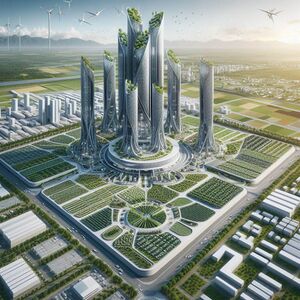
Industries and Sectors
Canespa has an economy dominated by the agriculture industry which makes up 76% of the nation's exports at a total of 750 million metric tons of food produced per year. This is followed by timber which makes up 13%, then dams/waterway-fees which make up 6% followed by all other industries. Canespa has a rich history of farming in the Cusinaut. This caused them to be a very tribal nation up until the 60s when the Canasta Company gained control of the government. The company was started in the 20s and slowly grew through the decades. Its strategy from the beginning was to fill a niche and profit greatly from it. Despite the vastly more profitable option of industrializing, Canasta's leadership decided to play the long game as it predicted the food shortages that would come with urbanization. As such Canespian grown food feeds much of the world.
Canespa’s agriculture is on the verge of being a monoculture with around 47% of all food grown in the nation are potatoes. These potatoes are farmed in various areas of the country from the vast Canespian hills and the terrace farms on them to the river basins of central and northeast Canespa. Potatoes are grown to such an extent in Canespa for many reasons as they are a calorie dense food that can grow almost anywhere. Along with this Canespa is the native climate of the potato. After potatoes are harvested from the ground they are then transported to Port Extranjero using a massive network of canals in the country known as the Qumir Canals. Once they reach the port they are then loaded onto and sold to Burgundian ships. After this Burgundie plays a large role in who the harvests are shipped to. Selling the food directly to Burgundie is an easy way to stabilize the economy of Canespa and lower the risks of any quick economic shift affecting the government's budget.
Along with potatoes Canespa produces , grapes, strawberries, blueberries, cherries, apples, cherries, peaches, pears, plums, prunes, nectarines, apricots, hazelnuts, walnuts, chestnuts, pecans, asparagus, zucchini, mushrooms, peppers, tomatoes, cucumbers, wheat, canola, oats and barley. Along with all of these is the second largest food export of Canespa, seafood. Canespian fisherman sail all along the coast catching various seafood including but not limited to salmon, halibut, rockfish, hake, sablefish, herring and tuna. Shellfish include clams, oysters, crab, prawns, geoduck, sea urchins, and sea cucumber. The seafood is often transported to Port Extranjero directly with the sea but the canals can be used additionally.
The largest non-agricultural industry in Canespa is lumber, this is thanks to the massive pine forests in the northern stretches of Canespa. Though lumber is not the focus of Canespian industry it is still a massive component of it providing Canespian’s with cheap wood. The types of wood cut down in Canespian forests includes but is not limited to coniferous or softwood, Douglas fir, western hemlock, Pacific silver fir, western red cedar, lodgepole pine and interior spruce. For every tree cut down in Canespa (including trees cleared for buildings) needs to be replaced with at least three saplings. This ensures a continuously growing economy. Additionally the Canasta Company has a constant fire watch patrol that ensures there are no forest fires or forest fire causing variables in and around company tree farms.
The Canespian industry is constantly evolving and new technologies are being created to assist in growth. Canespa’s largest tech department is specifically used to genetically modify plants to further their output. New machines are being developed to harvest wood and food faster and entire infrastructure projects are devoted to the production of food. Hamuq city is a prime example of all of these factors and will be a completely automated city that can produce more food than any other location on the planet. The Canespian industry is growing fast along with its population which is expected to surpass 100M by 2042.
Canespa's economy also extends into foreign lands through the Canasta Company, although areas outside the country don't technically consist of Canespa's economy, they do feed into it. The Canasta Company is international and has made deals in many areas including Varshan and the Iles Evangeline.
Currency
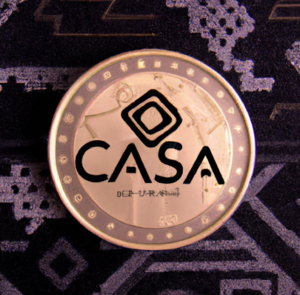
In 2027 Canespa updated its currency into the Capesa. An (almost) completely digital style of currency exchange. The Capesa is digital form of currency that is backed by electricity. One Capesa is equal to one Kilowatt of electricity. While this does lead to a slightly harder to control currency it means that Canespa can engage in trade deals with other nations that result in direct energy transfer. Thanks to this Canespa produces little energy of its own. Instead it imports most of its energy from other countries in exchange for food. Before this, Canespa was using the Taler because of its connections with Burgundie as they were the main trade partner of Canespa.
Do to the unstable nature of an energy based currency, Canespa has laws in place that allow for a rapid shift in how much things cost and how much employees are paid. It also leads to more Capesa's being dealt out whenever more energy starts to be produced. Of course due to the nature of the Canasta Company taxes are irrelevant and no taxes exist in the country. All the money paid out to employees is eventually used to buy goods which means the Canasta Company will get all of there money back eventually.
Healthcare
Medical care is provided by the Canasta Company, because of the agricultural nature of Canespa the hospitals in the country are required to possess at least 3 electric or biofuel helicopters. This is so that they can quickly reach any point in the country and back to a hospital as quick as possible. Healthcare in the nation is not entirely free but is heavily insured if you are an employee of the Canasta Company. Most hospitals are in the suyukuna's due to their more urban nature.
Labor
Labor is all controlled and conducted by the Canasta Corporation. While individuals do have a choice in profession, if one job is lacking numbers they will take less skilled individuals from others to make up for it. Most citizens end of in farming as its seen as a good hard working profession in Canespa. Most enter the workforce by sixteen or seventeen due to the lack of high education in the country. There are no labor unions in Canespa and they are strictly outlawed. Similarly there is no minimum wage and the Canasta Company has full control in what people receive, are payed, and what they have access to.
Workers within Canespa, especially in more rural areas. Are paid with a vary small amount of cash, instead, material wealth is used to pay workers. Better housing and better food are often given to the harder workers within Canespian society. This form of payment is more traditional to the land as currency has only been in use for a little over a century.
Transportation
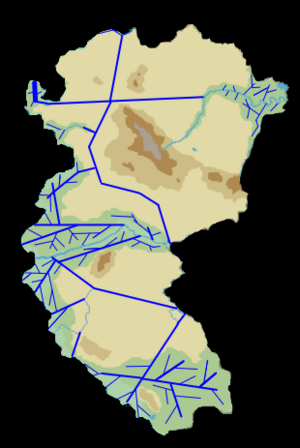
The people of Canespa get around using the Qumir Canals. A massive canal network within the country that is used to transport everything from military equipment to food to even people. In addition to the canals there is a high speed rail network between Canestapa, Port Extranjero, and Hamuq Cities construction cite. There are smaller outshoots of this rail network connecting to the smaller coastal cities of Canespa but these rail networks are expensive and not entirely tested so the canals have remained the main transportation device within the country.
Canespa also has relatively small road networks going through major cities with completely biofuel run cars that are imported into the country. It is illegal to use any non-government approved fuel.
Energy
Most of the people of Canespa have not had access to electricity till around the 1980s. Today most of the countries electricity is imported while some of it is brought in through dams built along the rivers flowing down from the mountains. These dams supply about 40% of Canespa's electricity requirements, while the rest is imported from the Cusinaut and Crona. Canespa is strictly against fossil fuels and any type of high pollution energy source. This is due to the belief that using these fuels directly harms the mother nature herself. This leads to Canespa also being one of the largest producers in biofuel. Biofuel is used to power almost every non electric powered device in Canespa.
Technology
Canespa has a small science department in most fields and usually relies on importing new technology into the country. One of the only major focuses of Canespa's science department is its agriculture division. Hamuq City relies heavily on this new farming technology that revolutionizes the amount of food that can be produced per worker. The department has experimented with genetically modifying plants and has made strides in the amount of time it takes the Potato plant and Tobacco plants to regrow. The potato plants growth time alone has been cut in half to around 30 days. The department also works on the development of new field equipment and has produced the Granjero Gen V and Gen Vl Tractors. These Tractors are absolute beasts that use treads instead of wheels causing less soil damage. They also have a 745 horsepower Biofuel engines. The department has already started work on the Granjero Gen Vll which is expected to come out in 2036.
Military wise the department has made the Mayu Uywa. A mechanical beast of a machine that was designed for the defense of Canespa. The Mayu Uywa crawls along the bottom of the canals, if there is a threat it will pop out of the water within 10 seconds and begin an onslaught of fire from its 4 mini turrets. The Mayu Uywa also has a main battle turret that is large enough to completely destroy enemy tanks within range. The country currently has 17 of these beasts roaming the depths of the canals.
Military
Canespa’s military is made up of five branches, the Canespian Defense Force, the Canespian Air Force, the Canespian Trade Protection Force, the Canespian Canal Defense Force, and lastly the Canespian Muchuy’s. The Canespian military is a 100% volunteer force.
The Canespian Defense Force or CDF contains 193,706 active members while there are 784,000 members in reserve. It is split into six different divisions all of which are stationed regionally in Canespa. The Canespian Air Force or CAF is made up of 152,896 active members with 406,000 in reserve. The Canespian Trade Protection Force or CTPF contains 167,809 members with 558,000 in reserve. The Canespian Canal Defense Force or CCDF contains roughly 67,000 active personnel with 80,000 in reserve. Lastly the Canespian Muchuy’s or the CM’s contain roughly 35,000 individuals with around 90,000 in reserve.
Canespian Defense Force
The CDF is a relatively untested force only fighting in a few wars and border skirmishes. Despite this the CDF has a strong sense of tradition and obedience that its members serve with. It is very much a quality over quantity force with all of its members being volunteers who trained for the military since their ascension into training camps from normal schooling. The CDF’s tank regiment consists of 55 AMY-82s along with 175 Canespian made Papua-60s. The AMY-82s are much more tested in combat. Canespa originally purchased three of them in 1998 for field testing. Just two years later Canespa purchased an additional 15 tanks and adopted the AMY-82 as its main battle tank. After a series of purchases in the following years Canespa obtained a total of 55 of them. The Papua-60 was designed in Canespa in the 1980s and most were produced up till 2017. They are relatively untested in battle and their overall design is quite weak but they are very good at moving around terrain. They are run completely on biofuel.
Canespian Air Force
The CAF is a tad smaller then the CDF and it is relatively new, only being founded in 1998 after the purchase of two attack helicopters and two aircraft. Canespa bought two Tiger Attack Helicopters and two Tucanos for training and evaluation. They were both soon adopted and eighteen of each were purchased. This was followed by a purchase of six more attack helicopters and the exchange of the Tucanos for fourteen Super Tucanos.
Canespian Trade Protection Force
The CTPF is one of Canespa's most important military divisions. The CTPF is more of a secondary back up force in case the ally in Burgundie fails at some point. It is also in charge of the protection of all non-Canespian produced products that need transported. The CTPF consists of 167,809 members with 558,000 in reserve.
The force is built around three destroyer squadrons. They are task assigned as the "Escort Fleet", the "Home Fleet", and the "Reserve Fleet" but none of them are fleet strength.
| Ship type | Total number in posession | Number on active duty | Number in reserve | Number under construction | Notes |
|---|---|---|---|---|---|
| Destroyers | 4 | 2 | 2 | 0 | |
| Frigates | 14 | 9 | 5 | 0 | |
| Corvettes | 12 | 7 | 5 | 0 | |
| Diesel-electric attack submarines | 3 | 2 | 1 | 0 |
Escort Fleet
The escort fleet is currently escorting all the seeds and farmers being sent over to the Iles Evangeline.
Home Fleet
Reserve Fleet
The reserve fleet is stationed in the South Kanchi port.
Canespian Canal Defense Force
The CCDF is almost strictly a force of defense within Canespa. With only 67,000 active personnel and 80,000 personnel in reserve, it is one of the smallest military branches. Outside of strictly personnel the force has 17 ocean crawling Maya Uywa's at its disposal. At least ten of the beasts are roaming the canals depths at all times. Along side of the Maya Uywa's the CCDF has several patrol vessels that police the canals. Along with this they have vehicles constantly patrolling the coast of the canal and cleaning up accidents. Along with this the CCDF will also help guide large ships through any area of the canal that is quite shallow or hard to pass. The CCDF isn't just a defense force though. They can pass through any body of water confined within the Cusinaut. They can even trek across the ocean for small amounts of time, no longer then an hour in order to avoid detection. Though they are almost useless as a weapon when not in relatively shallow water.
Canespian Muchuy
The CM’s are a highly trained group of elite Canespian units. They specialize in bio-warfare. There capabilities are untested but due to Canespa's known ability to genetically modify plants the CM's can likely do the same. They have roughly 35,000 individuals with around 90,000 in reserve. Exact numbers are hard to find due to the secrecy of the branch. The Muchuy's are rarely deployed due to the ethical stretch the government must make in order to use them. The legal and religious restrictions of the branch only allow for its use in a war that can not be won through traditional means.
See also


